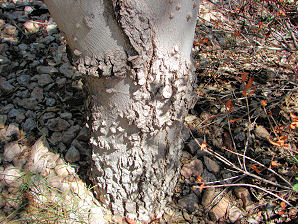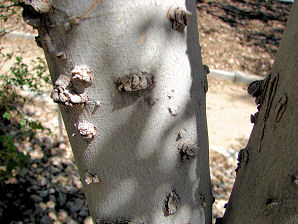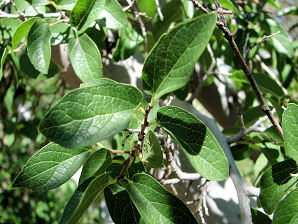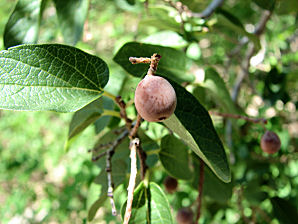Xeriscape Landscaping Plants For The Arizona Desert Environment.
Pictures, Photos, Information, Descriptions,
Images, & Reviews.
Trees.
Canyon Hackberry Trees, Celtis reticulata.
We Are Proud Of Our SafeSurf Rating!
Click On Any Of The Following Links By Amazon.Com
For Books, & Videos About Wildflowers Of Arizona & The Southwest USA. No Obligation!
| Canyon Hackberry, Celtis reticulata. September 13, 2006. Glendale, Arizona Xeriscape Demonstration Garden. |
|---|
 |  |
| Bark. Canyon Hackberry. Celtis reticulata. | Bark. Canyon Hackberry. Celtis reticulata. |
|---|---|
 |  |
| Leaves. Canyon Hackberry. Celtis reticulata. | Fruit. Canyon Hackberry. Celtis reticulata. |
Canyon Hackberry Tree.
We wish to thank Wikipedia, the free encyclopedia for some of the information on this page. We share images and information with Wikipedia. Canyon Hackberry is a shrub or small tree with a spreading irregular crown. When small it spreads in an irregular fashion. As a tree it can reach 30 feet tall with a 30 foot spread. Celtis reticulata is irregularly distributed from the Chihuahuan desert on the south to the arid plains of eastern Washington on the north. It is usually found in dry, rocky hillsides, canyons and dry stream beds from about 2,500 feet to 6,500 feet. It has a drooping form with twisted branches and trunks, with very densely divided branches and veined leaves. Canyon Hackberry's central range includes the Rio Grande region and the Chihuahuan Desert in southern Arizona-New Mexico, western Texas, and northern Sonora-Chihuahua-Coahuila. It also is found in Arizona and Sonora in the Madrean Sky Islands of the northern Sierra Madre Occidental; and in the White Mountains and Mogollon Rim of Arizona. It occurs at the Colorado River from the Grand Canyon northeast through Utah to western Colorado Celtis reticulata, with common names including netleaf hackberry', western hackberry, Douglas hackberry, netleaf sugar hackberry, palo blanco, & acibuche. It is often confused with the related species Celtis pallida, the spiny hackberry or desert hackberry, in Arizona. Also confused with Celtis occidentalis, the common hackberry, and Celtis laevigata, the sugarberry or southern hackberry. Netleaf Hackberry can be used to attract birds and wildlife into the landscape. In the lower desert it will not survive extended droughts without irrigation.
Quick Notes:
Height: Up To 30 feet, they spread out about 30 feet.
Trunk: The trunk bark forms vertical corky ridges that are checkered between the furrows.
Bark: Grey to brownish grey.
Flowers: The color is greenish, about 1/12 of an inch in diameter.
Blooming Time: Late February - April.
Fruit: about 5 - 12 mm in diameter, brownish to purple, pulp thin. Birds Love It!. Other animals eat it also.
Seeds: Hard, cream-colored, about 0.22 inch.
Leaves: Bright green, simple, saw-toothed elm tree-like leaves about 2 1/2 inches long.
Found: The USDA claims it is native to the USA (AZ, CA, CO, ID, KS, LA, NM, NV, OK, OR, TX, UT, WA, WY). In Arizona native to all counties except Yuma, & La Paz. In Mexico native to northern Sonora, northern Chihuahua, & Coahuila.
Elevation: Native at 2,500 - 6,500 feet.
Hardiness:
Soil pH requirements:
Sun Exposure:
Habitat: Pinyon-juniper woodlands. Also used for Xeriscape landscaping.
Miscellaneous: Flowering Photos Taken: March 26, 2006. Glendale Arizona Xeriscape Demonstration Garden. A low water use landscaping plant in the Phoenix and Tucson areas.
|
We Are Proud Of Our SafeSurf Rating!
Click On Any Of The Following Links By Amazon.Com
For Books, & Videos About Wildflowers Of Arizona & The Southwest USA. No Obligation!
| © 1966 - Present, Audrey, Eve, & George DeLange |
